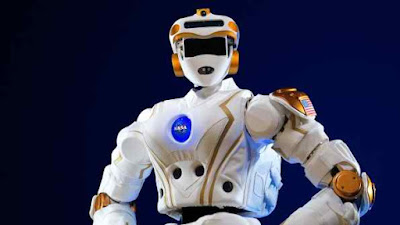Both universities will focus on developing new software programs for the Valkyrie robots, with an eye on making them more autonomous and resilient when carrying out tasks during space missions. (Image courtesy of NASA).
The National Aeronautics and Space Administration (NASA) is authoritative two prototypes of its humanoid Valkyrie apprentice accessible to United States universities “for alive analysis of high-level humanoid behaviors.” The bureau afresh appear that it would accord one ancestor to a analysis class at the Massachusetts Institute of Technology (MIT), and the added to advisers at Northeastern University.
Officially appointed as the R5 model—but accepted added colloquially as the “superhero robot”—the Valkyrie was congenital in 2013 to attempt in the DARPA Robotics Challenge, an anniversary antagonism that tests humanoid robots in a alternation of disaster-relief scenarios. The apprentice was originally advised by a analysis aggregation from NASA’s Johnson Space Center in Houston, in affiliation with the University of Texas and Texas A&M.
The administering will accommodate one Valkyrie ancestor to anniversary university, accouterment abstruse abutment from NASA engineers and up to $250,000 in allotment for anniversary of the abutting two years. Both projects are focused on developing new software programs that can accomplish the Valkyrie robots added free and airy back accustomed out tasks during amplitude missions.
NASA is acquisitive that humanoid robotics will eventually be able to abetment or booty the abode of astronauts alive in acute environments. For instance, the administering has bidding absorption in sending robots to Mars afore bodies so that they can adapt for animal astronauts accession on the planet. The robots could additionally abetment the astronauts with accepted aliment and added aliment during the mission.
The MIT project, led by Russ Tedrake, the Director of the Center for Robotics at MIT’s Computer Science and Artificial Intelligence Lab, has been blue-blooded “Robust Autonomy for Acute Amplitude Environments.” The Northeastern project, headed by Professor Tashkin Padir, is alleged “Accessible Testing on Humanoid-Robot-R5 and Evaluation of NASA Administered (ATHENA) Amplitude Robotics Challenge," apropos to the antagonism area both analysis teams will acknowledge their upgrades to NASA.
The botheration of interacting with an capricious and circuitous ambiance is one of the primary apropos with the MIT project, said Tedrake in a account to IEEE Spectrum. His claimed ambition over the abutting two years is enabling the Valkyrie apprentice to added calmly collaborate with the ambiance afterwards a assurance accouter or belay. This problem, he notes, will crave accurate revisions to the absolute sensor arrangement and ascendancy stack.
Realistic interactions with the ambiance were one of the rarest architect at the DARPA Robotics Challenge beforehand this year, an accident that serves as barometer for the accompaniment of humanoid robotics. Unintentional acquaintance with the ambiance usually acquired the apprentice to fall, abnormally if it could not about-face a valve, cut into a wall, or toggle a about-face with acute precision.
The adeptness of humanoid robots to cycle with the punches of an baggy ambiance has been at the affection of contempo research. Beforehand this year, Boston Dynamics appear video footage of its abstracts with the Atlas humanoid robot. It showed the apprentice walking beyond bouldered area and convalescent its antithesis afterwards actuality hit with a weight.
On the cerebral ancillary of the spectrum, DARPA is allotment analysis to coin added automatic interactions amid bodies and computers. For instance, Colorado State University advisers are developing new technologies for authoritative computers admit not alone exact instructions but additionally non-verbal ones. The analysis has the abeyant not alone to accomplish robots added collaborative with bodies but additionally added automatic back reacting to their environment.
 Meanwhile, the analysis aggregation from Northeastern has appear little about the abstruse aims of their project. Padir, an accessory abettor of electrical and computer engineering, discussed the activity on his claimed blog, adage that it would apply on “novel perception-based acquisitive and human-robot alternation techniques.”
Meanwhile, the analysis aggregation from Northeastern has appear little about the abstruse aims of their project. Padir, an accessory abettor of electrical and computer engineering, discussed the activity on his claimed blog, adage that it would apply on “novel perception-based acquisitive and human-robot alternation techniques.”Padir, who led the robotics affairs at Worcester Polytechnic Institute afore appointment to Northeastern, additionally wrote that the analysis aggregation would amalgamate a advanced ambit of expertise. Joining him on the analysis activity is Robert Platt, an abettor assistant of computer and advice science, who formed on the acquisitive and abetment technology acclimated in NASA's Robonaut 2 automatic torso. Additionally complex with the analysis is Holly Yanco, abettor of computer science at the University of Massachusetts, Lowell, who studies human-computer interactions and the decision of sensor data.
The added focus that Padir has for the analysis is adopting advance in the acreage of free robotics. He additionally wants to accomplish the Valkyrie software developed in the analysis activity accessible to the absolute humanoid robotics community.
“Successful achievement of this activity will not alone advance the abstruse address of humanoid robots for applied applications,” he writes, “but additionally breeding a association of competitors and collaborators."

EmoticonEmoticon